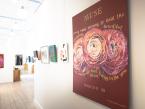For 13 years, nine artists have been meeting to discuss their work and offer constructive criticism. All women, their styles vary from landscapes to woodcuts. They share a passion for art and the desire to grow as artists. And they’ve continued to grow closer over the years. Their work will be the focus of a new art show at the Featherstone Center for the Arts, called Nine Artists — Thirteen Years.
The artists are Leslie Baker, Claire Chalfoun, Nancy Furino, Lyn Hinds, Hermine Hull, Ruth Kirchmeier, Jeanne Staples, Liz Taft and Wendy Weldon. They meet periodically to have a drink, catch up and discuss their work. These meetings offer the artists a sense of community that they might not ordinarily experience.
“It’s an opportunity for us to exchange ideas, to network, to look at each other’s work and to get feedback,” said Ms. Staples, a painter. “Working as a professional artist is very solitary work. The opportunity to get together and talk shop with others who are toiling similarly is a great outlet — you need somebody to help you with the nitty gritty stuff.”
Ms. Staples first joined the group eight or nine years ago when she connected with Ms. Taft through their art school’s alumni association.
She divides her work into three categories: landscapes, three-dimensional paintings and a series of interconnected, figurative narrative paintings, one of which currently hangs in the emergency room at the Martha’s Vineyard Hospital. Ms. Staples paints the same scene from two different angles in a self-described “classical and painterly” style. She then presents the images in three dimensions with a mirror configuration.
“I’m not sure they’ll be selling like hotcakes, but that’s not why I do them,” the artist said.
She said the group has helped to foster her creativity and help her art continue to be exciting.
“Having a group where you can bounce around ideas and get feedback is a really enriching experience for an artist,” Ms. Staples said. “It helps you to challenge yourself and keep pushing your art along.
Ms. Kirchmeier makes woodblock prints. Her father, a cabinetmaker in Germany, first exposed her to the art of woodworking.
“I grew up just loving the smell of wood,” she said. “It’s a medium that requires a great deal of concentration. I enjoy sitting and carving away for hours — I think that’s the German in me.”
After World War II, Ms. Kirchmeier’s father harbored a number of refugee artists in their home. She said it was a transformative experience. “I was among Olympians,” she said.
“I’m a member of this group because it gives me a focus for my work,” Ms. Kirchmeier continued. “I have a group of respected colleagues who will look at my work and talk straight about it — that’s reason enough to be doing it.”
Perched atop a grassy hillside on the site of the former Featherstone Farm off Barnes Road in Oak Bluffs, the Featherstone Center for the Arts was conceived in 1996 by a group of forward-thinking Islanders who saw a need for an art education center. A conservation purchase by the Martha’s Vineyard Land Bank aided the founding of the center by preserving the farmland.
The center provides a home for artists of all kinds. It offers classes in a range of visual arts, from abstract painting to ceramics, and its studio equipment often exceeds the kind of supplies that might ordinarily be available to a beginning artist.
Vestiges of the farm remain. In the horse barn that now houses Featherstone’s printmaking studio and photography darkroom, a collection of wood panels is nailed to a crossbeam in the ceiling. A name is stenciled onto each panel. Featherstone executive director Ann Smith said they are the names of the horses that at one time inhabited the barn. A panel bearing the name Featherstone hangs inconspicuously with the rest.
Facilities include two art galleries, painting and ceramics studios, a printmaking studio and, at the top of the hill, a wooden platform stage where local bands regularly perform. The land bank uses some of the pastureland for agricultural pursuits. Near the outdoor stage, people have planted colorful gardens; at the foot of the hill, a cow grazes in a pasture. The old farmhouse now houses Featherstone’s gallery. Warm yellow lights illuminate the gallery’s rich hardwood floors and framed art hangs on the walls. The space feels open but not empty. Although it was not yet ready for the show, Ms. Smith explained that the gallery’s enclosed porch will be set up as a simulated artist’s studio. Some of the artists’ rough drafts will be hung alongside the finished product to draw awareness to the process that goes into creating a work of art.
Monina Von Opel, the show’s curator, said the biggest struggle she faced in collecting art for the show was trying to find a common theme among all the artists’ work. But in most cases, the work was so varied in style that it defied any kind of connection. So instead of trying to relate dissimilar works of art, Ms. Von Opel decided to focus on the one aspect that all the artists share — the process of turning an idea into a work of art.
“Perfect works of art don’t just pop out on the wall,” Ms. Von Opel said. “The whole process will be visible. I wanted to show the influence of their meetings.”






Comments (3)
Comments
Comment policy »